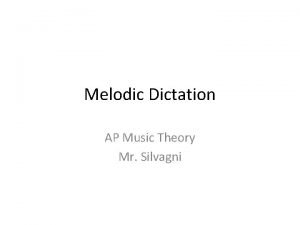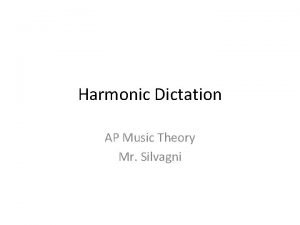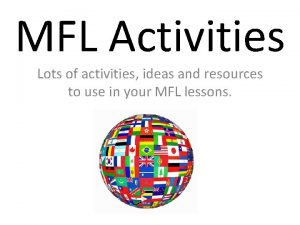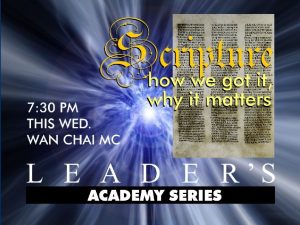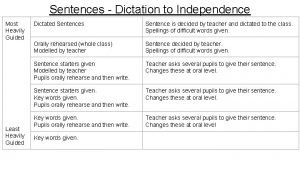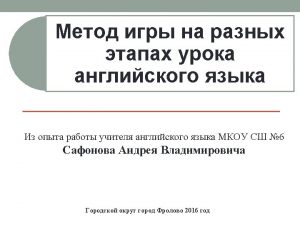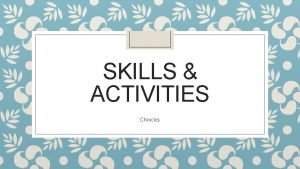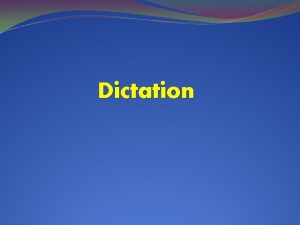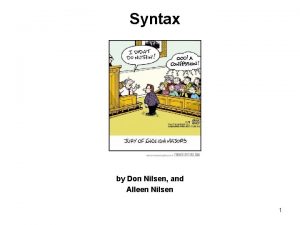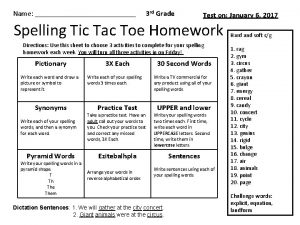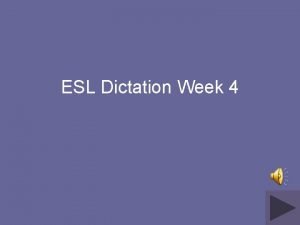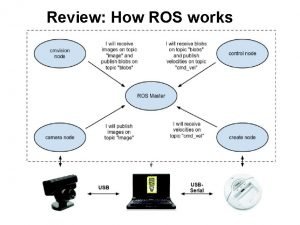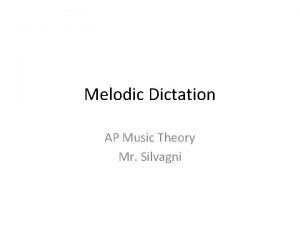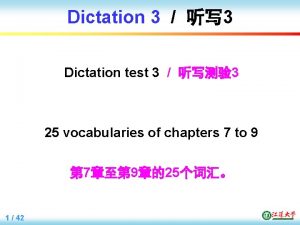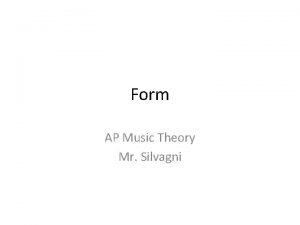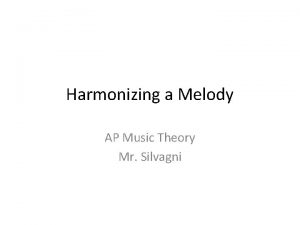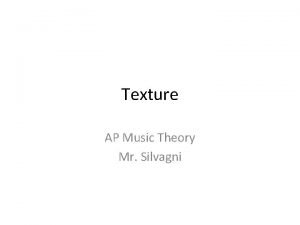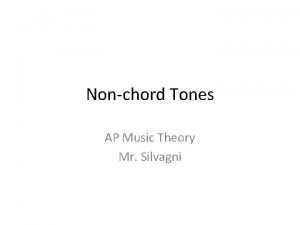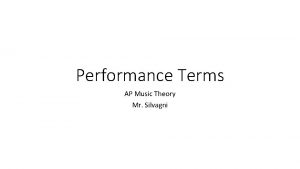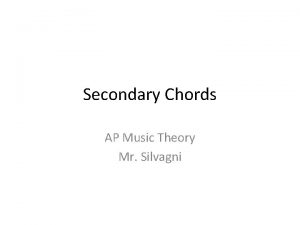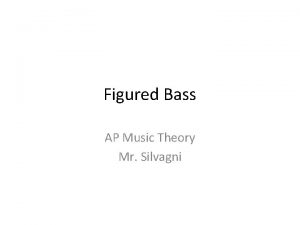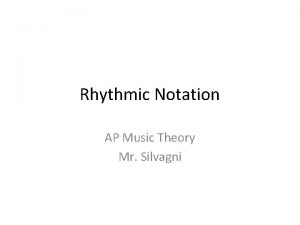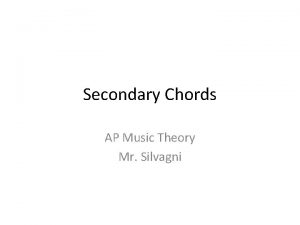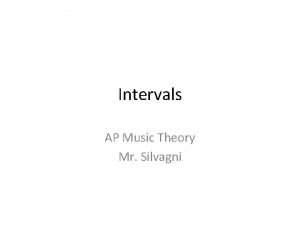Melodic Dictation AP Music Theory Mr Silvagni Melodic
















- Slides: 16

Melodic Dictation AP Music Theory Mr. Silvagni

Melodic Dictation • Melodic dictation is listening to a single line melody and writing down both the rhythm and pitch • It’s like the reverse of sight singing • Improving one’s ability to sight sing will improve dictation skills

AP Melodic Dictation • There are two melodic dictation questions on the AP test – One will be in treble clef and one will be in bass clef – One will be in simple meter and one will be in compound meter – One will be in major and one will be in minor – The melody will be played three times for the first example and four times for the second example

Skills for Melodic Dictation • Recognize the key • Recognize the meter and understand rhythm • Understand relationship of pitches to tonal center • Recognize familiar melodic and rhythmic patterns and their placement in the measure • Be able to draw note heads, stems, dots, beams, and flags that correspond to rhythm correctly • Be able to draw pitches on the staff correctly • Reproduce the melody in your head

Understand the Melody • Know the key and any altered notes (Fi) that may occur – Write down the full scale…write down altered minor scale notes (La and Ti) for reference • Common beginning patterns – Do Re Mi and Do Mi Sol are most common • Common ending patterns – Mi Re Do, Sol La Ti Do, Re Ti Do/Ti Re Do, Sol Ti Do/Fa Ti Do/Mi Ti Do, and Do Re Do/Do Ti Do • The middle generally implies a half cadence – Know the pitches in the V and V 7 chord (Sol Ti Re Fa) – Melody will be two symmetrical phrase (antecedentconsequent)…first phrase ends with half cadence and second with authentic (may have anacrusis)





Why is this hard? 1. Melody Memory – You can’t write what you can’t remember – Use solfège for dictation as well 2. Notation breakdown – Practice writing notes on staff paper – Know stems and beaming – Know how many beats are in a measure

More specific tips 1. If you can’t get it all, get all that you can – Don’t leave any beat blank – You don’t have to write the melody in sequential order…it’s easier to remember beginning and end, so write those first 2. Use logic and plan ahead – Clef and Key signature: identify and understand before you listen – Know which notes are which solfège syllables and where they’re written beforehand – The last note is always Do…write it in first – The last note is usually long rhythmically – Is there an anacrusis? If yes, it’s most likely Sol Do to start – Minor key? There will be a leading tone…you must put accidentals in – Compound meter? Review rhythms likely to appear from earlier – Secondary dominant implication will be in one of them (usually Fi)

More specific tips 3. How do melodies begin? – Major and minor: Do Re Mi or Do Mi Sol (Me for minor)…Do Ti Do for minor as well 4. How do melodies end? – – Mi Re Do or Sol Fa Mi Re Do Do Ti Do or Do Re Ti Do or Ti Re Do Fa Ti Do, Sol Ti Do, or Mi Ti Do (Me for minor)

More specific tips 5. What’s in the middle? – Anticipate mostly stepwise motion with some leaps – Leaps over a third are usually between Do and Sol – Anticipate a half cadence near the middle – Second half of melody often begins as anacrusis (if 4 measures, second half of measure 2)

More specific tips 6. Don’t write until you have heard the entire example – Try to sing the melody to yourself afterwards – If you need to write during, don’t write too much detail, rather sketch with shorthand – Leave markers for the melody contour, some specific pitches, rhythms, etc.

More specific tips 7. Don’t be afraid to use the back door – Meaning, you can write backwards – If all you remember is the last measure, then write it down – Compare the prior measure to how it relates to the last measure – Approach from both sides 8. When you are done knowing…GUESS – – Do NOT leave anything blank…blank = wrong Use your sketches or ideas to inform your guesses Try to think of which chordal tonalities you’ve heard If it’s in the middle, set up a half cadence, use tonic progressions for the beginning and end

Melodic Dictation Examples • Barron’s AP Music Theory • Music for Ear Training Textbook • AP Central
 Tips for melodic dictation
Tips for melodic dictation Dictation music theory
Dictation music theory Online music portfolio
Online music portfolio Strip bingo mfl
Strip bingo mfl Dynamic inspiration
Dynamic inspiration Dictation sentence examples
Dictation sentence examples Dictation in english
Dictation in english Rong chang dictation
Rong chang dictation Seen dictation
Seen dictation What is a dictogloss
What is a dictogloss Don nilsen
Don nilsen Grade 1 dictation sentences
Grade 1 dictation sentences Eslamerica us
Eslamerica us Melodic phrase
Melodic phrase How ros works
How ros works Interval diperlukan dalam penciptaan musik interval adalah
Interval diperlukan dalam penciptaan musik interval adalah Conjunct vs disjunct music
Conjunct vs disjunct music
